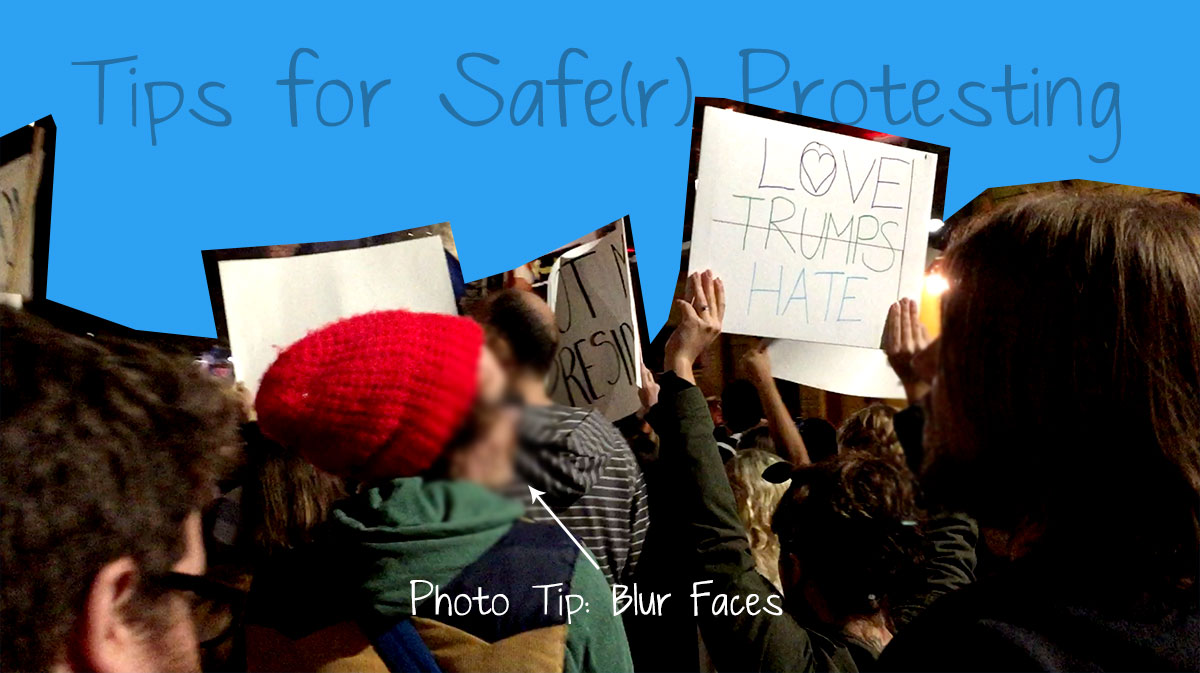Here are a few simple things (that may be obvious) I’ve learned from lots of civil disobedience (that are definitely obvious in hindsight). The following tips might come in handy for those of you taking to the streets for the first time.
I’ve organized and participated in a lot of political resistance over the years. From high school walkouts, to college sit-ins, to guerrilla activism campaigns, to marches and public demonstrations.
And I was guessing that, at the time of writing this (January 2017), a lot of folks in the U.S. would be wading into these waters for the first time that year (because Trump presidency year one), or the week I published this (because Women’s March on Washington). Turns out that guess was an understatement.
Three years later, as I’m updating this in May 2020, we’re taking to the streets all over the U.S. to demand justice for George Floyd, Breonna Taylor, and other victims of police brutality.
Big caveat: all of these are optional (obvs.), and depending on who you are, what you have access to (physically, financially, and otherwise), and the type of protest you’re attending, some of these may not be possible. I’m doing my best in this list to cover as many bases as possible. Use what you can use. And I love you.
PREP: Before the Protest
1. Make signs. Yes, plural (signs), if you can: fellow sign-less protestors will appreciate your extras. Ideally, you’ll have a unified voice through the signs, which will allow onlookers to know what you’re demonstrating. Check with organizers to see if there are any phrases, themes, or statements they’re hoping for. Or freak what you feel. Foam board and magnum sharpies are a great combo, but work with what you have, just aim for big, bold, legible letters.
2. Drink lots of water. The day before, and throughout the day of. Prepping with a lot of hydration will help you keep your voice, and keep your energy up.
3. Plan your exit. If you’re driving, park at least several blocks away from the protest. If you’re getting picked up, plan your ride beforehand (and make it at least several blocks away from the action).
4. Tell a friend who isn’t going. Let them know you’ll check in with them after (specify a check-in time), and give them an emergency contact number to reach out to if they don’t hear from you (a local civil rights lawyer is great, or a family member who you know will do everything they need to do to find you).
5. Write an emergency contact number on your body. If you’re arrested, this is the number you’re going to call. If you think, “I’m not doing anything illegal. I won’t be arrested,” I’d encourage you to do this anyhow. I’ve seen plenty of peaceful, lawful protestors get arrested. I generally write the number on my leg with a sharpie, and the number I choose is a friend who knows I’m at the protest, and whom I’ve given follow-up steps to (e.g., to call a certain lawyer, and to make a public statement on my social media profiles).
6. Charge your cell phone, and be prepared for it not to work anyhow. If you have one, make sure the battery is 100% (or as close as possible) before you head out the door. Depending on the size of the demonstration, cell service might be spotty (more on this in “action”), which will drain your battery faster than usual. Or it might be down completely (with huge groups), so plan to not need your phone.
7. Download this App from the ACLU for your state, if available. Have it installed and be familiar with it in case you need it.
8. Know the local laws regarding protest. Or, at least, know them well enough to know if the planned action is fully lawful, iffy, or downright illegal. Google is good for this, so is the ACLU. This might require you to reach out to the organizers to ask them what the plan is, which isn’t always possible (a lot of “organized” resistance is more resistant and less organized). The number one benefit of this, in my experience, is confirming your intuitive “that’s wrong” sense when you see law enforcement doing heinous things.
ACTION: During the Protest
9. Go with a friend (or make a friend there). Make sure you can contact this person’s fam or friends if they’re hurt, arrested, or disappear. And ditto for them to you. Keep an eye on one another, and watch one another’s backs. Look out for police officers who are pulling people from the crowd (it’s a bummer), or for onlookers who are throwing things at the crowd (surprise beer bottles to the head hurt… a lot).
10. Bring an external phone battery. If you have one (or several), bring it along. See #6 above. This is especially important if you’re planning on filming/streaming the protest with your mobile (see #13 below). If you have both lightning (Apple) and micro USB (Android) cables, it’d be nice to bring those, too (in case someone else is in need).
11. Wear comfy shoes. If you’ll be standing or walking, shirk fashion and go with comfort. Ditto for the rest of your apparel.
12. Bring/wear a mask (read: something to cover your face, not a halloween costume, unless that’s your thing). A bandana is my go-to. Scarves are great. A lot of people on the sidelines and in the march itself may be filming, and both law enforcement _and _opposition groups may use that footage to identify and dox protestors. If you cover half your face, you should be okay. Bonus: a bandana will also come in handy in the event of tear gas or pepper spray (see #14).
13. If you film/stream, try not to catch fellow protestors’ faces. You can also blur faces in photos/video after (if you have the digital editing chops). This isn’t always possible, and is a bit of a contentious topic in activist circles I’m in (one side: we should stream and film to signal boost, and make the demonstration available to those who couldn’t attend; other side: we should not stream or film, because doing so helps cops/opposition identify and dox protestors). If possible, do film any cops who are violating laws (see #7) or doing things that seem wrong (see #8). This may not save the day (there’s lots of footage of cops doing horrendous things to protestors, to no avail), but it’s better to have the record than not have it.
14. Water makes pepper spray worse. So do contact lenses. If you suspect pepper spray or tear gas will be used by law enforcement, I’d suggest reading this beforehand. Milk, vinegar, lemon juice, and other solvents will help. Just don’t use water. Or lotion. Learn from my and others’ terrible experience.
RECOVERY: After the Protest
17. If you’re not safe and sound, ask for help. Depending on what’s happened, rely on your community, the fellow protestors, or your friends/family. The ACLU is a great resource. Just don’t feel pressured to deal with whatever happened on your own.
18. Follow-up with the organizers, or other protestors, for next steps. A protest is a lily pad, not the pot o’ gold at the end of the rainbow. There might be immediate action (e.g., a bailout fund if someone was arrested) needed, so check in.
19. Share your experience! This will help increase the reach of the protest, and maybe inspire others to get involved. A blog post, social media update, or just telling friends with your mouth are all great.
More Apps/Resources
For those who are curious, here are a few links to keep learning, or tools that will help you in the future.
FireChat – Apple iOS / Android – free instant messaging that doesn’t require signal or mobile data, great for huge crowds
Signal – Apple iOS / Android – encrypted messaging through SMS, great for planning communication
Beautiful Trouble – a book and online resource with tons of protesting info and explainers, or “a toolbox for revolution.”
That’s all, comrades. Be smart, protect yourself, watch out for one another, and let your voice be heard.


